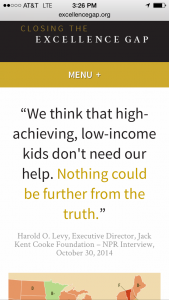| Apr 20, 2015
Social Marketing Meets New Product Launch

Most people draw a clear line between conventional marketing of products and services, and social marketing, which broadly defined applies marketing principles to change human behavior in order to improve health or benefit society.
But what happens when you bring a social issue forward that almost nobody knows even exists — one that goes to the very heart of an American ideal as old as the Declaration of Independence.
We hold these truths to be self-evident, that all men are created equal.
True in countless respects, but not when it comes to gauging a child’s future academic success. Some children simply are born “gifted” or “talented” — and that wealth of talent spreads equally across all segments of the American population, regardless of race, religion, geography or family income.
Researchers count about 3.4 million academically gifted American school children in grades K-12 who happen also to be poor. Here is where the story gets interesting. Year after year, grade after grade, America loses many of these high-achieving, low-income students.
All poor American school children — now the majority — swim upstream when it comes to school resources. High-ability, low-income students face unique challenges — from peer stigma to a lack of teachers trained to work with gifted students, to a shortage of college guidance counselors.
Among those high-achieving, low-income students who persist and overcome barriers, the great majority do not attend select colleges — despite years of academic performance, test scores and their demonstrated resilience that show readiness. Researchers call this phenomenon “undermatching” — which says that poor smart kids are more likely to display college application pattens that match their financial peers rather than their academic peers from higher income brackets — even though select colleges have the endowments needed to provide the needed financial aid. In fact, family income, not high school academic performance, is a stronger indicator of a student’s ability to earn a college degree in America — that’s how onerous the financial demands have become.
The Virginia-based Jack Kent Cooke Foundation partnered with Elliance in an effort to raise broad awareness of these issues and to influence national and state education policy to better support high-achieving, low-income students.
“The longer smart, poor kids stay in school, the less likely that they are to remain at the top of their class,” says Harold O. Levy executive director of the Cooke Foundation. “That’s a repudiation of the American Dream, and the foundation is determined to do everything we can to turn that around.”
Careful attention was given to site architecture and content strategy for the responsive excellencegap.org microsite — balancing the need to inform audiences of an issue most had never encountered with the goal of underscoring that the Jack Kent Cooke Foundation remains, at heart, a grant maker and convener.
 In the initial weeks since launch, the “excellence gap” issue has attracted attention from the New York Times, Washington Post, and many other national and regional media outlets. A longer range inbound marketing (blog, social media and SEO) campaign will follow to build on that momentum and sustain the discussion through the long process of policy and public opinion change.
In the initial weeks since launch, the “excellence gap” issue has attracted attention from the New York Times, Washington Post, and many other national and regional media outlets. A longer range inbound marketing (blog, social media and SEO) campaign will follow to build on that momentum and sustain the discussion through the long process of policy and public opinion change.
While social marketing launch strategies may differ from a conventional product launch, there is much to learn and borrow on both sides. As we advance the excellence gap issue beyond the media and policy makers, the next challenge involves tackling a whole range of closely held assumptions that educators, counselors, youth development leaders and college admissions staffs hold regarding who is gifted in America.
